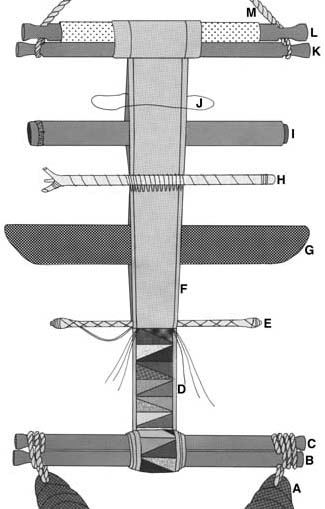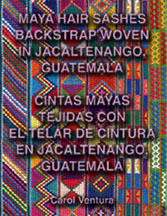The Backstrap Loom
of
Jacaltenango, Guatemala
 |
The "Y" shaped tie cord (M) has a two
inch loop on each of its two short ends. The long end of the cord averages fifty three
inches in length, while each of the shorter ends average fourteen inches.
The lease
cord (J); is tied into the shed while the warp is still on the warping frame
where the shed bar will be positioned. The lease cord maintains the order of the warp
threads and remains until the hair sash has been completely woven. When the shed roll
slips out of position (this sometimes happens when the loom is not under tension), the
lease thread is lifted to form an opening, then the shed roll is slipped into place. The shed
roll (I) divides the warp in half. In Jacaltenango it is always constructed of a
hollow cane or bamboo. It often has pebbles or seeds inside the core to make noise as the
woven hair sash is beaten. The cane's natural joint forms one end of the container
and the other end is plugged with paper after the seeds or pebbles have been inserted. The
shed roll averages three quarters of an inch in diameter and is the same length as the end
rods and like them, turns brown and shiny with age and use. The heddle rod (H) consists
of a debarked stick, approximately eight inches long, that has three or more prongs on one
end. The heddle thread is spirally wrapped around the stick. The heddles are actually
closer together than they appear in the illustration. The heddle rod is also highly
regarded by the weaver; she will not part with it. When commissioning pieces still on the
loom, I had to provide a set of four end rods, a beater, and a heddle stick because of the
attachment that weavers have for these loom parts. The beater (G) is made
of a heavy wood and is usually around eleven inches long by one and a quarter inches wide.
The thick rounded top edge tapers to a sharp knife-like edge on the bottom. The beater is
perhaps the most precious part of the loom to a weaver. They are sometimes handed down
from mother to daughter. The warp (F) may be either single or double for
the hair sashes. The floral and the striped geometric hair sashes are usually woven with a
single warp. The other geometric hair sashes are woven with a paired warp. The weft
bobbin (E) is approximately seven inches long. The weft is spirally wrapped
around the stick back and forth. The supplementary wefts (D) are extra.
If they were to be removed, the integrity of the woven cloth would remain intact. The cloth
end rods (B and C) and the warp end rods (K and L) need only be
long enough to sustain the warp and to comfortably allow the loom to be stretched between
a support and the weaver (usually the width of the warp plus approximately four inches on
each side). All four of the rods average ten inches in length and a half inch in width.
The end rods of the loom are precious to each weaver. They are esteemed and coveted when
they are old and brown. An average size for backstrap (A) is two inches
by eighteen inches with two fifteen inch loops. |

|
For a closer look, you might enjoy Maya Hair Sashes Backstrap Woven in Jacaltenango /
Cintas mayas tejidas con el telar de cintura en Jacaltenango, Guatemala,
a bilingual book that features this Jakaltek backstrap loom, backstrap weaving, and the beautiful hair sashes of the Jakaltek women, from both anthropological and artistic perspectives. The 176 page paperback book includes 38 illustrations, 116 black and white photographs, and 15 color photographs. (ISBN 0-9721253-1-0). You may order a signed copy with a credit card by clicking the "buy now" button on the left (only for shipping to an address in the United States). This price includes free shipping in the United States . If you would like a personalized dedication with the signature, please mention it in the "instructions to merchant" box on the PayPal page. |
Maya Hair Sashes . . .
Book Reviews:
Journal of Latin American Anthropology, November 2005
. . . The precise documentation of the tools and
techniques of the weaving process of the hair sash in Carol Ventura's bilingual
work is a propos here since it deals with the preservation of knowledge of the
tradition. For Ventura, the artist and art historian, 1986 was the culmination
of four and one-half years of working with the Jakaltek weavers in Guatemala.
Her view of the learning process at that time, which included learning by
observation and use of the toy loom, accords with Greenfield. Ventura returned
in 1996 and in 2002. Although in 1986 weaving was an important activity that
established group identity and social cohesiveness, by 2002 weaving was rapidly
disappearing. The weaving cooperative had become a general store and there was
less foreign demand for hair sashes and wall hangings. The hair sash designs had
evolved from simple geometric patterns to elaborate designs appropriated from
German silk ribbons. It was the only item of local dress still woven in 2002 in
Jacaltenango. This and the fact that Jakaltek textiles are still a commodity
will, in Ventura's opinion, keep weaving alive in the near future. The picture
given by Ventura of the changes between 1986 and 2002 is very much in keeping
with those mentioned in the previous two books. Communication and contact via a
road system and technology; the telephone, television, and the Internet -
provide contact with the broader world. More schools and a university branch
have widened horizons. A cash economy and the remittances sent by emigrants have
enabled economic life will beyond subsistence levels, much as the
commoditization of textiles has empowered women. . . Virginia Davis
Choice,
November 2004, 42.3: 473
Contemporary Mayan material culture has received cursory attention from scholars
outside of its relevance to ancient Mesoamerica studies. Textile production and
trade have been intrinsic to the life of Mayan peoples since before the Common
Era, but much about their history remains unknowable. Ventura (Tennessee
Technological Univ.), a compassionate historian and skilled weaver, documents in
detail the history, method, style, and patterns in the backstrap-woven hair
sashes worn and sold by Jakaltek women living in a remote area of modern
Guatemala. Sections on Mesoamerican religion and mythology and pre-Columbian
symbolism of weaving, in conjunction with a useful bibliography in English and
Spanish, makes this a key resource for historians, anthropologists, and
practitioners. Ventura contributes the first comprehensive account of the
backstrap looming method and the conservation and transformation of traditional
patterns and their meanings, including templates and step-by-step instructions
for weavers. All documented areas are supported by carefully composed
photographs of Jakaltek people and places, especially women working at their
looms, and legible close-ups of many specific sashes. Unfortunately, very few
illustrations are in color; color is significant to several designs that, in
some cases, have revealed for generations the social status of individual
Jakaltek women. Summing Up: Highly recommended. General readers; lower-division
undergraduates through professionals. M. R. Vendryes, York College, CUNY
Handwoven, May/June 2004: 20-21
Carol Ventura, also the author of books on
tapestry crochet under the name Carol Norton, learned to weave Jakaltek hair
sashes while serving as a Peace Corps Volunteer in Guatemala in the late 1970's.
She learned to speak Spanish and the local language, Popti', and spent several
years working with the Jakaltek weavers of Jacaltenango. Her doctoral
dissertation on hair sashes was published in 1989. The first edition of this
book was published in 1996 by Yax Te' Press.
The Jakalteks have lived in the highlands
of northwest Guatemala since pre-Columbian times. The women maintain their
traditional clothing style. The hair sash is the only item that is still locally
woven. It is an important trade item and is exported worldwide.
While the designs on the sashes may appear
to be embroidered, they are actually created as the fabric is woven. Jakalteks
use a double-faced supplementary-weft brocade technique to create a variety of
geometric and pictorial motifs on a warp-faced fabric.
This is more than a book documenting hair
sashes. The technical information includes a valuable analysis and comparison of
forty-five hair sashes collected between 1927 and 1989. In addition, a wealth of
historical background is presented in a very readable style. One chapter
summarizes the development of weaving in the area, beginning with the first
evidence of pre-Columbian textiles. The fibers and the tools used to create the
hair sash, as well as the double-sided brocading technique used by the weavers,
are all well documented. Black-and-white photos show the steps involved in using
the warping frame and the loom - there is even a photo showing a blind man
making a ply-split backstrap from 2-ply sisal. Another chapter documents the
physical and spiritual importance of weaving and clothing to the Jakalteks that
includes sections on pre-Columbian cosmology, weaving deities, and the symbolism
of huipiles, hair sashes, colors, and motifs.
Many interesting footnotes supplement the
text, along with charming photographs of women warping and weaving. The four
pages of color photographs show over fifty sashes, and the instructions will
enable readers to reproduce the designs. Anyone interested in weaving should
enjoy this book, especially those who want to know more about Guatemalan
Textiles. Linda Hendrickson
página en español
Links:
Backstrap Weaving in Jacaltenango, Guatemala
Backstrap Weaving School in Santa Maria del Rio, Mexico
Backstrap Woven Shawls of Esperanza Valencia Morra of Morelia, Mexico
Toba Sashes of Argentina with Pickup Motif
Foot-Loom Weaving in Central Mexico
Gobelin Tapestry Weaving in Dolores Hidalgo, Mexico
Songket Weaving in Bali, Indonesia
Tapestry Crochet
Web page, photographs, and text by Carol Ventura. Please look at
Carol's home page to see more about crafts around the world.

